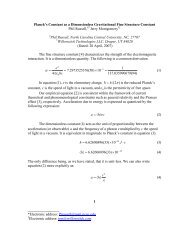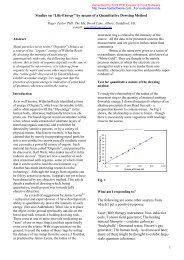Viktor Schauberger
Viktor Schauberger
Viktor Schauberger
Create successful ePaper yourself
Turn your PDF publications into a flip-book with our unique Google optimized e-Paper software.
As far back as 1938, a German expedition to the Antarctic was made with the aircraft<br />
carrier Schwabenland (Swabia). 600,000 km2 of an ice-free area with lakes and mountains<br />
were declared German territory, the "Neuschwabenland" (New Swabia). Whole fleets of<br />
submarines of the 21 and 23 series were later headed towards Neuschwabenland. Today<br />
about one hundred German submarines are still unaccounted for, some equipped with the<br />
Walter snorkel, a device that allowed them to stay submerged for several weeks, and it can<br />
be assumed that they fled to Neuschwabenland with the dismantled flying disks or at least<br />
the construction plans. Again it must be assumed that since the test flights had been very<br />
successful some so-called flying saucers have flown directly there at the end of the war.<br />
There is the question raised as to why in 1947, Admiral E. Byrd led an invasion of the<br />
Antarctic, why he had 4,000 soldiers, a man-of-war, a fully equipped aircraft carrier and a<br />
functioning supply system at his command if it was a mere expedition? He had been given<br />
eight months for the exercise, but they had to stop after eight weeks and high losses of<br />
planes undisclosed even today. What had happened? Later Admiral Byrd spoke to the press:<br />
"It is the bitter reality that in the case of a new war, one had to expect attacks by<br />
planes that could fly from Pole to Pole." Further he added that there was an advanced<br />
civilization down there that used their excellent technologies together with the SS. Is this<br />
report true? Who really can answer that question?!<br />
Norbert-Jurgen Ratthofer writes about the whereabouts of the Haunebu developments in<br />
his book "Zeitmaschinen" . Time Machines: "The Haunebu I, II and III space gyros and<br />
the VRIL I space flying disk had disappeared after May 1945... It is very interesting to note<br />
in this context that after its nineteenth test flight, the German Haunebu III is said to have<br />
taken off on April 21, 1945, from Neuschwabenland, a vast, officially German territory in the<br />
Eastern Antarctic, for an expedition to Mars, about which there is nothing further known.<br />
One year later, in 1946, the many sightings that suddenly occurred in Scandinavia of<br />
shining objects of unknown and definitely artificial origin caused a great stir among the







